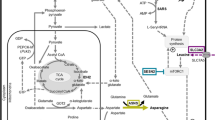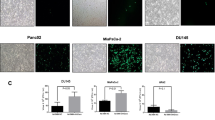Abstract
The primary function of the adenovirus ElA-region genes is to activate other adenoviral genes during a permissive viral infection by modifying the host cell transcriptional apparatus1,2. Host cell immortalization, or transformation by the whole adenoviral early region, presumably results as a consequence of these modifications. Both transcriptional activation and transcriptional repression of non-adenoviral genes by the E1A proteins have been reported3–9. It is currently not clear which, if either, of these activities contributes to host cell transformation and immortalization. Although there may be a physiological impact of some ElA-stimulated host cell genes10–12, in many cases the functional significance is unclear, No common target sequences have been recognized in stimulated cellular genes and it has recently been proposed that in many cases, particularly involving newly transfected genes, available 'TATA-box' sequences may be the opportunistic beneficiaries of ElA assistance as a secondary consequence of ElA primary functions within the host cell nucleus1,13. ElA-mediated transcriptional repression appears to be a more specific process insofar as common core elements are shared by the ElA-suppressed SV40, polyoma B, IgG heavy-chain and insulin enhancers9. In the present communication we report that the complete myogenic programme of L8 and C2 myoblasts can be blocked by the introduction of constitutively expressing ElA genes, and show that the transcriptional induction of muscle-specific genes is inhibited. In particular, the promoter-inducing activities of well-defined elements that are required for the muscle-specific expression of the two sarcomeric a-actins, and which normally bind cellular trans-acting factors, become targets for E1A suppression. The results support the hypothesis that the suppression of differentiation by ElA products is effected by an ElA-mediated block in the transcriptional activation of cellular genes by specific developmentally regulated cis-acting promoter elements.
This is a preview of subscription content, access via your institution
Access options
Subscribe to this journal
Receive 51 print issues and online access
$199.00 per year
only $3.90 per issue
Buy this article
- Purchase on Springer Link
- Instant access to full article PDF
Prices may be subject to local taxes which are calculated during checkout
Similar content being viewed by others
References
Berk, A. J. A. Rev. Genet. 20, 45–79 (1986).
Kingston, R. E., Baldwin, A. S. & Sharp, P. A. Cell 41, 3–5 (1985).
Moran, E. & Matthews, M. B. Cell 48, 177–178 (1987).
Lillie, J. W., Green, M. & Green, M. R. Cell 46, 1043–1051 (1986).
Velcich, A. & Ziff, E. Cell 40, 705–716 (1985).
Hen, R., Borrelli, E. & Chambon, P. Science 230, 1391–1394 (1985).
Hen, R., Borrelli, E., Fromental, C., Sassone-Corsi, P. & Chambon, P. Nature 321, 249–251 (1986).
Velcich, A., Kern, F. G., Basilico & Ziff, E. B. Molec. cell Biol. 6, 4019–4025 (1986).
Stein, R. W. & Ziff, E. B. Molec. cell Biol. 7, 1164–1170 (1987).
Simon, M. C. et al. Molec. cell Biol. 7, 2884–2890 (1987).
Zerler, B., Roberts, R. J., Matthews, M. B. & Moran, E. Molec. cell Biol. 7, 622–639 (1987).
Hoeffler, W. K. & Roeder, R. G. Cell 41, 955–963 (1985).
Wu, L., Rosser, D. S. E., Schmidt, M. C. & Berk, A. Nature 326, 512–515 (1987).
Smith, D. H., Kegler, D. M. & Ziff, E. D. Molec. cell Biol. 5, 2684–2696 (1985).
Wakeman, M. J. O. Biochem. J. 228, 1–12 (1985).
Entwistle, A., Curtis, D. H. & Zelin, R. J. J. Cell Biol. 103, 857–866 (1986).
Endo, T. & Nadal-Ginard, B. Cell 49, 515–526 (1987).
Minty, A. & Kedes, L. H. Molec. cell Biol. 6, 2125–2136 (1986).
Minty, A., Blau, H. & Kedes, L. H. Molec. cell Biol. 6, 2137–2148 (1986).
Mayer, Y., Czosnek, H., Zeelon, P. E., Yaffe, D. & Nudel, U. Nucleic Acids Res. 12, 1087–1100 (1984).
Miwa, T. & Kedes, L. Molec. cell Biol. 8, 2803–2813 (1987).
Muscat, G. & Kedes, L. Molec. cell Biol. 7, 4089–4099 (1987).
Falcone, G., Tato, F. & Alema, S. Proc. natn. Acad. Sci. U.S.A. 82, 426–430 (1985).
Massague, J., Cheifetz, S., Endo, T. & Nadal-Ginard, B. Proc. natn. Acad. Sci. U.S.A. 83, 8206–8210 (1986).
Olson, E. N., Spizz, G. & Tainsky, M. A. Molec. cell Biol. 6, 2104–2111 (1987).
Baldwin, E. & Kaylar, C. Proc. natn. Acad. Sci. U.S.A. 83, 8029–8033 (1986).
Yee, A. S., Reichel, R., Kovesdi, I. & Nevins, J. R. EMBLO J. 6, 2061–2068 (1987).
SivaRaman, L., Subramanian, S. & Thimmappaya, B. Proc. natn. Acad. Sci. U.S.A. 83, 5914–5918 (1986).
Devaux, B., Glenn, A. & Kedinger, C. Molec. cell Biol. 7, 4560–4563 (1987).
Babis, L. E., Young, C. S. H., Fisher, P. B. & Ginsberg, H. S. J. Virol. 40, 454–465 (1983).
Gunning, P. et al. Molec. cell Biol. 7, 4100–4114 (1987).
Author information
Authors and Affiliations
Rights and permissions
About this article
Cite this article
Webster, K., Muscat, G. & Kedes, L. Adenovirus E1A products suppress myogenic differentiation and inhibit transcription from muscle-specific promoters. Nature 332, 553–557 (1988). https://doi.org/10.1038/332553a0
Received:
Accepted:
Issue Date:
DOI: https://doi.org/10.1038/332553a0
This article is cited by
-
Viral manipulation of the host epigenome for oncogenic transformation
Nature Reviews Genetics (2009)
-
The transcription-repression domain of the adenovirus E1A oncoprotein targets p300 at the promoter
Oncogene (2008)
-
HPV E7 expression in skeletal muscle cells distinguishes initiation of the postmitotic state from its maintenance
Oncogene (2003)
-
E1A: Tumor suppressor or oncogene? Preclinical and clinical investigations ofE1A gene therapy
Breast Cancer (2001)
-
Long-term fate of terminally differentiated skeletal muscle cells following E1A-initiated cell cycle reactivation
Cell Death & Differentiation (2000)
Comments
By submitting a comment you agree to abide by our Terms and Community Guidelines. If you find something abusive or that does not comply with our terms or guidelines please flag it as inappropriate.



